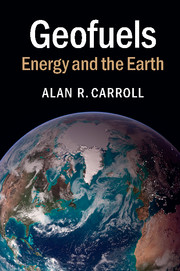Book contents
- Frontmatter
- Contents
- Acknowledgments
- 1 Introduction
- 2 The Living Earth
- 3 Warmed from Above: Solar Energy
- 4 Wind, Water, and Waves: Energy from the Fluid Earth
- 5 Covered in Green: Biofuels Basics
- 6 Fossil Farming: The Geologic Underpinnings of Biofuels
- 7 The Light of an Ancient Sun: Fossil Fuel Origins
- 8 Digging for Daylight: Coal and Oil Shale
- 9 Skimming the Cream: Conventional Oil and Gas
- 10 Stuck in the Mud: Fossil Fuels That Fail to Flow
- 11 Petrified Petroleum: Oil Sand and Gas Hydrate
- 12 Water, Water, Everywhere
- 13 Primordial Power: Geothermal and Nuclear
- 14 Out of Sight, Out of Mind: Geologic Waste Disposal
- 15 How Long Is Forever? Energy and Time
- 16 Conclusions
- Index
- References
8 - Digging for Daylight: Coal and Oil Shale
Published online by Cambridge University Press: 05 March 2015
- Frontmatter
- Contents
- Acknowledgments
- 1 Introduction
- 2 The Living Earth
- 3 Warmed from Above: Solar Energy
- 4 Wind, Water, and Waves: Energy from the Fluid Earth
- 5 Covered in Green: Biofuels Basics
- 6 Fossil Farming: The Geologic Underpinnings of Biofuels
- 7 The Light of an Ancient Sun: Fossil Fuel Origins
- 8 Digging for Daylight: Coal and Oil Shale
- 9 Skimming the Cream: Conventional Oil and Gas
- 10 Stuck in the Mud: Fossil Fuels That Fail to Flow
- 11 Petrified Petroleum: Oil Sand and Gas Hydrate
- 12 Water, Water, Everywhere
- 13 Primordial Power: Geothermal and Nuclear
- 14 Out of Sight, Out of Mind: Geologic Waste Disposal
- 15 How Long Is Forever? Energy and Time
- 16 Conclusions
- Index
- References
Summary
FO'SSIL. adj. [fossilis, Latin; fossile, French] That which is dug out of the earth.
COAL. n.f. [col, Sax.; kol Germ. kole, Dutch. kul, Danish] The common fossil fewel.
Excerpts from Dictionary of the English Language, Samuel Johnson, 1755The word “fossil” is taken from the Latin verb fodere, which means to dig. In modern usage “fossil” refers to any remnant, imprint, or trace of past life. Some common examples include dinosaur bones, buried clamshells, or mineralized wood. The most abundant fossils also turn out to be the smallest: shells and other remains of one-celled organisms that lived in the surface waters of the ocean and in lakes. More broadly, the term “fossil” also includes things like footprints, burrows, or leaf impressions that have been preserved in rocks.
On the basis of the modern definition of fossil, it is debatable whether the term “fossil fuel” accurately describes coal, petroleum, and natural gas. There is virtually no doubt that these substances originated in living organisms, but it is generally difficult to associate them with any unique biologic precursors. Instead they represent the highly modified remains of various different organisms that have been commingled into a kind of generic stew. Rather than being analogous to, say, a dinosaur skeleton, fossil fuels are more like a dinosaur that has been run through a meat grinder, bones, teeth, and all, along with several other types of dinosaurs and whatever smaller animals happened to wander by. It would be a clever curator who could reconstruct a meaningful museum exhibit from the resulting fossil sausage.
The term “fossil” was originally used much more broadly, however, to mean anything that was dug out of the Earth. This included not only fossils in the modern sense, but also metals, ore minerals, rock salt, gemstones, and certain materials that can support combustion. Coal, the most notable example of the latter, has been used as a heat source for millennia.
- Type
- Chapter
- Information
- GeofuelsEnergy and the Earth, pp. 142 - 164Publisher: Cambridge University PressPrint publication year: 2015



